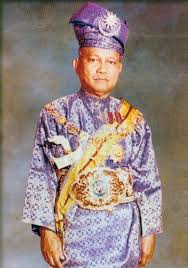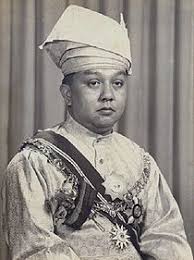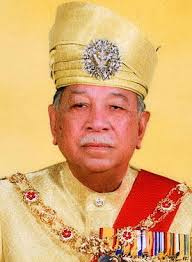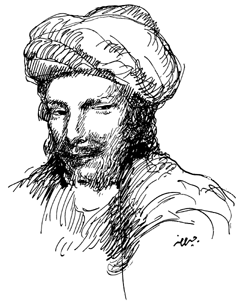INBREEDING
.
.
Kenapa tulis tajuk ni? On the 21st of February, I had a discussion with my boss on the constraints faced by the Air Force due to budget shortage. The AOG rate was increasing badly. The consequences effect will be the reduction of flying hours and the repercussion is less flying hours for the pilots and also 'pressure' to the serviceable aircraft. Another effect will be, the Air Force unable to take part in some of air exercise especially joint-exercise with the foreign forces. Embarrasing.
End up, our pilots will be flying among them (in-country) - a learn from you, you learn from me. Within the small community with a limited boundary. My Commander said 'inbreeding'. The word is not common to me. Based on my understanding, it means 'tak berkembang'. After coming back from the discussion, I wanted to know more about what is 'inbreeding'.
Here were are.
Inbreeding is the reproduction from the mating of two genetically related parents. Inbreeding results in increased homozygosity, which can increase the chances of offspring being affected by recessive or deleterious traits. This generally leads to a decreased fitness of a population, which is called inbreeding depression.
Livestock breeders often practice controlled breeding to eliminate undesirable characteristics within a population, which is also coupled with culling of what is considered unfit offspring, especially when trying to establish a new and desirable trait in the stock.
In plant breeding, inbred lines are used as stocks for the creation of hybrid lines to make use of the effects of heterosis. Inbreeding in plants also occurs naturally in the form of self-pollination.
Results
Inbreeding may result in a far higher phenotypic expression of deleterious recessive genes within a population than would normally be expected. As a result, first-generation inbred individuals are more likely to show physical and health defects, including:
· Reduced fertility oth in litter size and sperm viability
· Increased genetic disorder
· Fluctuating facial asymmetry
· Lower birth rate
· Higher infant mortality
· Slower growth rate
· Smaller adult size
· Loss of immune system function
Natural selection works to remove individuals with the above types of traits from the gene pool. Therefore, many more individuals in the first generation of inbreeding will never live to reproduce. Over time, with isolation such as a population bottle neck caused by purposeful (assortative) breeding or natural environmental stresses, the deleterious inherited traits are culled.
Island species are often very inbred, as their isolation from the larger group on a mainland allows for natural selection to work upon their population. This type of isolation may result in the formation of race or even speciation, as the inbreeding first removes many deleterious genes, and allows expression of genes that allow a population to adapt to an ecosystem. As the adaptation becomes more pronounced the new species or race radiates from its entrance into the new space, or dies out if it cannot adapt and, most importantly, reproduce.
The reduced genetic diversity that results from inbreeding may mean a species may not be able to adapt to changes in environmental conditions. Each individual will have similar immune systems, as immune systems are genetically based. Where a species becomes endangered, the population may fall below a minimum whereby the forced interbreeding between the remaining animals will result in extinction.
Natural breedings include inbreeding by necessity, and most animals only migrate when necessary. In many cases, the closest available mate is a mother, sister, grandmother, father, grandfather... In all cases the environment presents stresses to remove those individuals who cannot survive because of illness from the population.
There was an assumption that wild populations do not inbreed; this is not what is observed in some cases in the wild. However, in species such as horses, animals in wild or feral conditions often drive off the young of both genders, thought to be a mechanism by which the species instinctively avoids some of the genetic consequences of inbreeding. In general, many mammal species including humanity's closest primate relatives avoid close inbreeding possibly due to the deleterious effects.
Examples
The cheetah was once reduced by disease, habitat restriction, overhunting of prey, and competition from other predators to a very small number of individuals. All cheetahs now come from this very small gene pool. Should a virus appear that none of the cheetahs have resistance to, extinction is always a possibility. Currently, the threatening virus is feline infectious peritonitis, which has a disease rate in domestic cats from 1%–5%; in the cheetah population it is ranging between 50% to 60%. The cheetah is also known, in spite of its small gene pool, for few genetic illnesses.
In the South American sea lion, there was concern that recent population crashes would reduce genetic diversity. Historical analysis indicated that a population expansion from just two matrilineal lines were responsible for most individuals within the population. Even so, the diversity within the lines allowed for great variation in the gene pool that may help to protect the South American sea lion from extinction.
In lions, prides are often followed by related males in bachelor groups. When the dominant male is killed or driven off by one of these bachelors, a father may be replaced with his son. There is no mechanism for preventing inbreeding or to ensure outcrossing. In the prides, most lionesses are related to one another. If there is more than one dominant male, the group of alpha males are usually related. Two lines are then being "line bred". Also, in some populations such as the Crater lions, it is known that a population bottleneck has occurred. Researchers found far greater genetic heterozygosity than expected. In fact, predators are known for low genetic variance, along with most of the top portion of the tropic levels of an eco-system. Additionally, the alpha males of two neighboring prides can potentially be from the same litter; one brother may come to acquire leadership over another's pride, and subsequently mate with his 'nieces' or cousins. However, killing another male's cubs, upon the takeover, allows for the new selected gene complement of the incoming alpha male to prevail over the previous male. There are genetic assays being scheduled for lions to determine their genetic diversity. The preliminary studies show results inconsistent with the outcrossing paradigm based on individual environments of the studied groups.
Calculation
The inbreeding is computed as a percentage of chances for two alleles to be identicaly by descent. This percentage is called "inbreeding coefficient". There are several methods to compute this percentage, the two main ways are the path method and the tabular method.
Typical inbreeding coefficient percentages are as follows, assuming no previous inbreeding between any parents:
· Father/daughter, mother/son or brother/sister → 25%
· Grandfather/granddaughter or grandmother/grandson → 12.5%
· Half-brother/half-sister → 12.5%
· Uncle/niece or aunt/nephew → 12.5%
· Great-grandfather/great-granddaughter or great-grandmother/great-grandson → 6.25%
· Half-uncle/niece or half-aunt/nephew → 6.25%
· First cousins → 6.25%
· First cousins once removed or half-first cousins → 3.125%
· Second cousins or first cousins twice removed → 1.5625%
· Second cousins once removed or half-second cousins → 0.78125%
· Third cousins or second cousins twice removed → 0.390625%
· Third cousins once removed or half-third cousins → 0.195%
An inbreeding calculation may be used to determine the general genetic distance among relatives by multiplying by two, because any progeny would have a 1 in 2 risk of actually inheriting the identical alleles from both parents.
For instance, the parent/child or sibling/sibling relationships have 50% identical genetics.
NOTE: For siblings, the degree of genetic relationship is not an automatic 50% as it is with parents and their children, but a range from 100% at one extreme, as in the case of identical twins (who obviously cannot mate as they are the same sex), to an exceedingly unlikely 0%. In other words, siblings share an average of 50% of their genes, but unlike the 50% ratio between parents and children, the actual ratio between siblings in any given case can vary.
Linebreeding is a form of inbreeding. There is no clear distinction between the two terms, but linebreeding may encompass crosses between individuals and their descendants or two cousins. This method can be used to increase a particular animal's contribution to the population. While linebreeding is less likely to cause problems in the first generation than does inbreeding, over time, linebreeding can reduce the genetic diversity of a population and cause problems related to a too-small genepool that may include an increased prevalence of genetic disorders and inbreeding depression.
Humans
Genetic disorders
Autosomal recessive disorders occur in individuals who have two copies of the gene for a particular recessive genetic mutation. Except in certain rare circumstances, such as new mutations or uniparental disomy, both parents of an individual with such a disorder will be carriers of the gene. These carriers do not display any signs of the mutation and may be unaware that they carry the mutated gene. Since relatives share a higher proportion of their genes than do unrelated people, it is more likely that related parents will both be carriers of the same recessive gene, and therefore their children are at a higher risk of a genetic disorder. The extent to which the risk increases depends on the degree of genetic relationship between the parents: The risk is greatest when the parents are close relatives and lower for relationships between more distant relatives, such as second cousins, though still greater than for the general population.
A 1998 review found 1-4% increased morbidity for offsprings of first cousins compared to offsprings of unrelated parents. A 1994 review found 4.4% increased mortality for offspring of first cousins. After controlling for several sociodemographic factors, infant mortality for offspring of first cousins had odds ratios of 1.36, 1.28, and 1.32 for the neonatal, postneonatal, and infant period. There has been little research on how inbreeding affects common adult disorder although some preliminary evidence support effects on many such disorders including cardiovascular diseases and common cancers. Many previously not identified genetic disorders have first been recognized in highly endogamous communities and the mutation causing the disease may be unique to such communities.
A review of 48 studies of children born to cousins found that most of the children were healthy, with birth defects affecting 4% of births for consanguineous couples compared to 2% for the general population.
Prohibitions to inbreeding
The taboo of incest has been discussed by many social scientists. As anthropologists attest, this taboo exists in most cultures. As inbreeding within the first generation often produces expression of recessive traits, the prohibition has been discussed as a possible functional response to the requirement of culling those born deformed, or with undesirable traits. Some biologists like Charles Davenport advocated traditional forms of assortative breeding, i.e., euggenics, to form better "human stock".
Some Hindus follow the Gotra system, which prescribes prohibition of marriages among relatives based on a name attached to paternal relatives, to prevent inbreeding. Direct inbreeding is also prohibited in Islam, as described in the Quran (Surah 4, Ayat 23).
Royalty and nobility
The family relationships of royalty are usually very well known, leading observers to view royalty as highly inbred, but they are often comparable to many ethnic groups where the relationships are not publicized as well. Royal intermarriage was often practised to protect property, wealth, and position.
· In ancient Egypt, royal women carried the bloodlines and so it was advantageous for a pharaoh to marry his sister or half-sister; in such cases a special combination between endogamy and polygamy is found. Normally the old ruler's eldest son and daughter (who could be either siblings or half-siblings) became the new rulers. All rulers of the Ptolemaic dynasty from Ptolemy II were married to their brothers and sisters, so as to keep the Ptolemaic blood "pure" and to strengthen the line of succession. Cleopatra VII (also called Cleopatra VI) and Ptolemy XIII, who married and became co-rulers of ancient Egypt following their father's death, are the most widely known example.
· Among European monarchies Jean V of Armagnac formed a rare brother-sister relationship. Also other royal houses, such as the Wittelsbachs had marriages among aunts, uncles, nieces, and nephews. The British royal family had several marriages as close as the first cousin, but none closer.
· One of the most famous example of a genetic disorder aggravated by royal family intermarriage was the House of Habsburg, which inmarried particularly often. Famous in this case is the Habsburger (Unter) Lippe (Habsburg jaw/Habsburg lip/"Austrian lip") (mandibular prognathism), typical for many Habsburg relatives over a period of six centuries. The condition progressed through the generations to the point that the last of the Spanish Habsburgs, Charles II of Spain, could not properly chew his food.
· Besides the jaw deformity, Charles II also had a huge number of other genetic physical, intellectual, sexual, and emotional problems. It is speculated that the simultaneous occurrence in Charles II of two different genetic disorders: combined pituitary hormone deficiency and distal renal tubular acidosis could explain most of the complex clinical profile of this king, including his impotence/infertility which in the last instance led to the extinction of the dynasty.
· Another famous genetic disease that circulated among European royalty was hemophilia. Because the progenitor, Queen Victoria, was in a first cousin marriage, it is often mistakenly believed that the cause was consanguinity. However, this disease is generally not aggravated by cousin marriages, although rare cases of hemophilia in girls (though not including Victoria) are thought to result from the union of hemophiliac men and their cousins.
· Intermarriage within European royal families has declined in relation to the past. Inter-nobility marriage was used as a method of forming political alliances among elite power-brokers. These ties were often sealed only upon the birth of progeny within the arranged marriage. Thus marriage was seen as a union of lines of nobility, not of a contract between individuals as it is seen today.
· Some Peruvian Sapa Incas married their sisters; in such cases a special combination between endogamy and polygamy is found. Normally the son of the old ruler and the ruler's oldest (half-)sister became the new ruler. The Inca had an unwritten rule that the new ruler must be a son of the Inca and his wife and sister. He then had to marry his sister (not half-sister), which ultimately led to the catastrophic Huáscar's reign, culminating in a civil war and then fall of the empire.
· The Chakri Dynasty of Thailand has included marriages between cousins as well as more close relatives. The current king, Bhumibol Adulyadej is a first-cousin once removed of his wife, Sirikit, the two being respectively a grandson and a great-granddaughter of Chulalongkorn. The parents of the king's father, Mahidol Adulyadej, were half-siblings, both being children of Mongkut by different mothers.
Isolated groups
Among genetic populations that are isolated, opportunities for exogamy are reduced. Isolation may be geographical, leading to inbreeding among people in remote mountain valleys. Or isolation may be social, induced by the lack of appropriate partners, such as Protestant princesses for Protestant royal heirs, in which case inbreeding is desired. Since the late Middle Ages, it is the urban middle class that has had the widest opportunity for outbreeding and the least desire to inbreed.
Some inbreeding may enhance fertility rate
A recent study in Iceland by the deCODE genetics company, published by the journal Science, found that third cousins produced more children and grandchildren, suggesting that "in spite of the fact that bringing together two alleles of a recessive trait may be bad, there is clearly some biological wisdom in the union of relatively closely related people. For hundreds of years, inbreeding was historically unavoidable in Iceland due to its then tiny and isolated population.
Inbreeding in Malaysian Royal Families
I found a website titled 'royalark.net' contains the genealogies of Royal families in the world. These include the existing Rulers and that had ceased in Africa, Asia and American countries. I have not finished reading the website, however based on my spot reading, I found that there are connection through marriage among the Malay Rulers of nine states. But so far I could conclude that the practice of 'inbreeding', happen clearly in Negeri Sembilan royal families. The followings are the inbreeding practiced in Negeri Sembilan:







Other than the family of Sultan Azlan Shah (the present Sultan Perak) the marriages among the Royal families is also quite obvious in Perak palace. But in Perak, we have to understand that the selection of the Sultan is different from the other states. In Perak, the rotation for the throne is selected by a rotation of three royal family. Therefore, if the marriage among the royal family in Perak is not mere to the practice of inbreeding. Herewith, some of my finding to show some of the marriage among the Royal families in 9 Malay States are as follows:
- Tuanku Abdul Rahman ibni almarhum Tuanku Muhammad berkahwin dengan Tunku Kurshiah binti Tunku Besar Burhanuddin. Tunku Burhanuddin ibni almarhum Tuanku Antah adalah bapa saudara kepada Tuanku Abdul Rahman. Maka, Tunku Kurshiah adalah sepupu kepada Tuanku Abdul Rahman.
- Tunku Nasir Alam (adik Tuanku Abdul Rahman) berkahwin dengan sepupunya Tunku Maimunah binti Tunku Mabang (ibu Tunku Maimunah adalah adik kepada Tuanku Muhammad).
- Tuanku Munawir ibni almarhum Tuanku Abdul Rahman berkahwin dengan Tunku Duratun Nafisa Aziba (Durah) binti Tunku Besar Burhanuddin- (Tunku Durah adalah adik seibu sebapa kepada Tuanku Kurshiah (ibu tiri kepada Tuanku Munawir)- maknanya Tunku Durah adalah ibu saudara tiri kepada Tuanku Munawir.
- Tuanku Jaafar ibni almarhum Tuanku Abdul Rahman (adik Tuanku Munawir berlainan ibu) berkahwin dengan Tunku Najihah binti Tunku Besar Burhanuddin (Tunku Najihah adalah adik berlainan ibu kepada Tuanku Kurshiah (ibu tiri kepada Tuanku Jaafar) dan juga adik Tunku Durah (kakak ipar Tuanku Jaafar)- maknanya Tunku Najihah juga adalah ibu saudara tiri kepada Tuanku Jaafar.

almarhum Tunku Besar Burhanuddin
.
.
.
Other than the family of Sultan Azlan Shah (the present Sultan Perak) the marriages among the Royal families is also quite obvious in Perak palace. But in Perak, we have to understand that the selection of the Sultan is different from the other states. In Perak, the rotation for the throne is selected by a rotation of three royal family. Therefore, if the marriage among the royal family in Perak is not mere to the practice of inbreeding. Herewith, some of my finding to show some of the marriage among the Royal families in 9 Malay States are as follows:
- Johor-Perak
- Sultan Ibrahim ibni almarhum Sultan Iskandar berkahwin dengan Raja Zarith Sofia binti almarhum Sultan Idris alMutawakil Alallahi Shah.
- Johor-Negeri Sembilan:
- Tunku Abdul Rahman (almarhum) ibni almarhum Sultan Ismail berkahwin dengan Tunku Shahariah binti almarhum Tunku Abdul Rahman.
- Johor-Perlis
- Tunku Sulaiman ibni Tunku Abu Bakar ibni almarhum Sultan Ibrahim berkahwin dengan Sharifah Salwa binti almarhum Tuanku Syed Putra Jamalullail.
- Johor-Terengganu:
- Tunku Puteh Abdullah ibni almarhum Sultan Ali Iskandar ibni almarhum Sultan Hussain Shah berkahwin dengan Tengku Ngah Aishah ibni almarhum Sultan Zainal Abidin.
- Kedah-Negeri Sembilan
- Sultan Abdul Halim alMuadzam Shah ibni almarhum Sultan Abdul Hamid Halim Shah berkahwin dengan almarhum Tuanku Bahiyah binti almarhum Tuanku Abdul Rahman.
- Kedah-Selangor:
- Tengku Abdul Malik ibni almarhum Sultan Badlishah berkahwin dengan Tunku Sharifah Raudzah binti almarhum Sultan Hishamuddin Alam Shah.
- Kedah-Terengganu:
- Sultan Badlishah (almarhum) berkahwin dengan Tengku Asma binti almarhum Sultan Sulaiman Badrul Alam Shah.
- Negeri Sembilan-Terengganu
- Tuanku Munawir (almarhum) ibni almarhum Tuanku Abdul Rahman berkahwin dengan Tengku Aishah Rohani binti Tunku Besar Mahmud ibni almarhum Sultan Zainal Abidin III.
- N.Sembilan-Selangor:
- Tunku Ahmad Shah ibni almarhum Sultan Salahuddin Shah berkahwin dengan Tengku Irina ibni almarhum Tuanku Jaafar.
- Pahang-Johor
- Sultan Abdullah ibni almarhum Sultan Hj Ahmad Shah berkahwin dengan Tunku Azizah Maimunah Iskandariah binti almarhum Sultan Iskandar.
- Pahang-Negeri Sembilan:
- Tunku Dato Sri Azlan Shah ibni almarhum Sultan Abu Bakar Riayatuddin Muadzam Shah berkahwin dengan Tengku Jawahir ibni almarhum Tuanku Jaafar.
- Perak-Terengganu:
- Raja Dato Seri Iskandar Zulkarnain ibni almarhum Sultan Idris Shah Afifullah berkahwin dengan Tunku Soraya ibni almarhum Tengku Abdul Aziz ibni Sultan Sulaiman Badrul Alam Shah.
- Perlis-Selangor
- Tuan Syed Amir Zainal Abidin ibni almarhum Tuanku Syed Putra berkahwin dengan Tunku Hajjah Zahariah ibni almarhum Sultan Sulaiman Abdul Aziz Shah.
- Tuan Syed Zainal Anwar ibni almarhum Tuanku Syed Putra berkahwin dengan Tunku Nur Zihan binti almarhum Sultan Salahuddin Abdul Aziz Shah.
- Perlis-Terengganu:
- Tuanku Syed Sirajuddin ibni almarhum Tuanku Syed Putra berkahwin dengan Tunku Fauziah bintin Tunku Abdul Rashid ibni almarhum Sultan Sulaiman Badrul Alam Shah.
- Selangor-Johor:
- Tunku Sulaiman ibni almarhum Sultan Salahuddin Abdul Aziz Shah berkahwin dengan Tunku Kamariah Maimunah Aminah Iskandariah ibni almarhum Sultan Iskandar.
- Selangor-Terengganu:
- Tunku Abdul Halim ibni almarhum Sultan Alaeddin Sulaiman Shah berkahwin dengan Tengku Wok Atiqah ibni almarhum Sultan Sulaiman badrul Alam Shah.
- Terengganu-Pahang:
- Sultan Zainal Abidin III (almarhum) ibni almarhum Sultan Ahmad Shah berkahwin dengan Tengku Long binti almarhum Sultan Sir Ahmad Muadzam Shah.
- Sultan Sulaiman Badrul Alam Shah (almarhum) ibni almarhum Sultan Zainal Abidin III berkahwin dengan Tengku Mariam ibni almarhum Sultan Ahmad Muadzam Shah.
- Terengganu-Kedah:
- Tengku Abdul Aziz ibni almarhum Sultan Sulaiman Badrul Alam Shah berkahwin dengan Tengku Hamidah ibni almarhum Sultan Badlishah.
- Terengganu-Kelantan:
- Tengku Abd Rashid ibni almarhum Sultan Sulaiman Badrul Alam Shah berkahwin dengan Tengku Puteri ibni almarhum Sultan Ibrahim.
- Terenggan-Pahang:
- Tengku (Sultan) Ali ibni almarhum SultanSulaiman Badrul Alam Shah berkahwin dengan Tengku Ainul Jamal ibni almarhum Sultan Abu Bakar Riayatuddin Shah.
- Tengku Abdul Rahman ibni almarhum Sultan Sulaiman Badrul Alam Shah berkahwin dengan Tengku Puteri Nur Aziah binti almarhum Sultan Abu Bakar Riayatuddin Muadzam Shah.
- Terengganu-Selangor:
- Sultan Mahmud alMuktafi Billah (almarhum) berkahwin dengan Tengku Bariah ibni almarhum Sultan Hishamuddin Alam Shah..

No comments:
Post a Comment